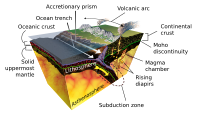
Photo from wikipedia
Accretionary wedge is the typical product of subduction-zone processes at shallow depths. Determining the location, composition and mechanism of accretionary wedge has important implications for understanding the tectonism of plate… Click to show full abstract
Accretionary wedge is the typical product of subduction-zone processes at shallow depths. Determining the location, composition and mechanism of accretionary wedge has important implications for understanding the tectonism of plate subduction. The Central Asian Orogenic Belt (CAOB) is one of the world’s largest accretionary orogenic belts, and records the bulk evolution of Paleo-Asian Ocean from opening to closure, with multi-stages and multi-types of crust-mantle interaction in the Paleozoic. West Junggar (western part of Junggar Basin), located in the core area of CAOB, is characterized by a multiple intra-oceanic subduction system during the Paleozoic. In its eastern part crop out Devonian-Carboniferous marine sedimentary rocks, Darbut and Karamay ophiolitic mélanges, alkali oceanic island basalts, island arc volcanic rocks and thrusted nappe structure. Such lithotectonic associations indicate the occurrence of accretionary wedge at Karamay. In order to decipher its formation mechanism, this paper presents a synthesis of petrography, structural geology and geochemistry of volcanic rocks. In combination with oceanic subduction channel processes, it is suggested that the accretionary wedge is a composite mélange with multiple stages of formation. The application of oceanic subduction channel model to the Karamay accretionary wedge provides new insights into the accretion and orogenesis of CAOB.
Journal Title: Science China Earth Sciences
Year Published: 2017
Link to full text (if available)
Share on Social Media: Sign Up to like & get
recommendations!